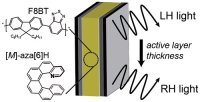[14:16 Tue,9.July 2019 by Thomas Richter] |
A research project by Imperial College in London shows a way to make OLED (Organic Light Emitting Diodes) displays - whether in smartphones, televisions or monitors - twice as efficient as before. Up to now, the layer with the light-imitating de.wikipedia.org/wiki/Organische_Light-emitting diodes (OLEDs) has been fitted with a reflection filter which, while greatly improving the visibility of the screen in bright outside light and filtering incident light from the side, also absorbs around half the light from the organic light-emitting diodes. This means that the OLEDs must shine twice as brightly as the display appears to the user - and half of the energy consumed is wasted all the time.de.wikipedia.org/wiki/Organische_Lighting diode The researchers have now developed a new type of OLED that emits a special polarized light that can pass through the anti-glare filter unhindered - twice as efficient as previous OLEDs. Since the display of mobile devices such as smartphones always absorbs a large part of the energy, the new OLEDs would allow significantly longer operating times (or smaller battery sizes) or significantly brighter screens. OLED monitors and televisions could also benefit from the new technology and thus work much more energy-efficiently or achieve significantly higher brightness levels. And they could also reduce one of the major disadvantages of OLED technology to date: the (relatively) short service life due to the lower heat generated by the energy swallowed by the filter. This would be important for the future viability of OLEDs - especially in view of the upcoming competition with Bild zur Newsmeldung:
deutsche Version dieser Seite: In Zukunft doppelt so effiziente OLED-Displays |






